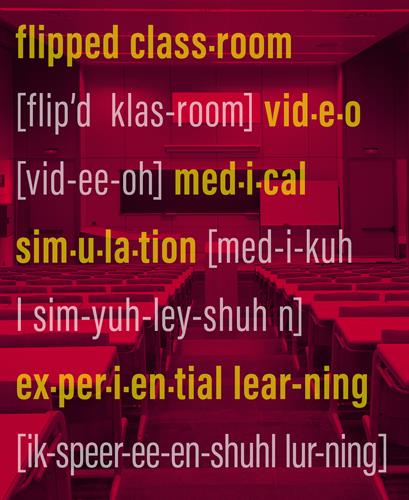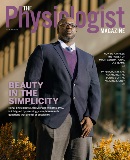Trend Setters
Physiology professors share some of the hottest trends in education—new ideas that became invaluable as the coronavirus forced universities into online-only learning.
By Melanie Padgett Powers and Wendy Lyons Sunshine

As science advances at breakneck speed, educators have been adopting new teaching methods and developing creative ways to engage 21st century learners. Embracing technology and innovation quickly became more important as the world was struck by the coronavirus pandemic this year.
As universities shuttered and classrooms went online, professors were forced to quickly adjust to this new virtual world. We spoke to several physiology professors about how the latest trends in education have allowed them to adjust their teaching styles and remain connected to their students.
Today, students are not considered empty vessels into which facts get poured; they are active participants in the learning process. Barbara Goodman, PhD, FAPS, first noticed this trend when accreditation agencies began reducing lecture requirements for medical training and replacing those hours with problem-based, case-based and team-based teaching. Now these types of active-learning, student-centered approaches have trickled down to undergraduate programs as well.
Goodman, a professor at the University of South Dakota Sanford School of Medicine, took the helm as editor-in-chief of Advances in Physiology Education in January 2020.
“It bothers me when anybody says, “I have to cover that in lecture,”” Goodman says. “There's no such thing as “covering” anymore. Information is so readily available by the internet today that we don't cover it anymore. We just have to help our students figure out what’s most important and how to think through parts of physiology that they haven't had a chance to think about before.”
Research has found that during flipped classroom activities, students multitask less and instead spend more time in focused, deep learning than during traditional lectures.
“All of the evidence is that active learning and student-centered approaches and doing activities together in class are the best way for people to learn,” says Goodman, who teaches physiology to advanced undergraduates and occupational therapy doctoral students. Apart from briefly reviewing the assigned material, Goodman never lectures. Instead, she makes her way around the classroom to support students who are busy with assigned human physiology experiments or online case studies or developing projects for presentation to classmates.
This type of in-person activity disappeared when the coronavirus hit, however. Anne Crecelius, PhD, says trying to recreate active group work in a virtual environmental can be challenging, but it is possible. Crecelius, associate professor and interim chair of the Health and Sport Science Department at the University of Dayton in Ohio, has used breakout rooms in Zoom along with Google Docs that students work on live.
Beyond laptops and cellphones, digital technology and multimedia are woven throughout today’s learning experience. The increase of video in the past few years made the transition to distance-learning easier this year, says Thomas Pressley, PhD, FAPS, professor in the Department of Medical Education and the Department of Cell Physiology and Molecular Biophysics at Texas Tech University Health Sciences Center in Lubbock. In-house videos “ensure that the learning experience remains institution specific,” he says. Plus, it helps departments build a content library.
When on campus, Crecelius used Zoom for guest speakers, which had numerous benefits. She too was able to build a content library by recording these “visits.” And it was often easier to schedule the guest speakers because they didn’t have to travel to campus and no audiovisual equipment had to be arranged. Crecelius had her students join the Zoom video calls, which allowed them to practice video conferencing—a skill that came in handy after classrooms became online only.
“This was many students’ first experience with video conferencing for a professional reason (not a social FaceTime call),” she says. “Now that we are in a distance-learning model and many colleagues are incorporating Zoom into their classes, these students have the advantage of having had this practice.”
In her classrooms, Goodman assigns interactive video segments using the ADInstruments online resource. ADInstruments is an APS partner and is offering its Lt online teaching platform for free through June 30. Students can follow along to perform simple experiments on themselves or watch case studies of real patients. These feature clinical evaluations and interviews with family members, doctors and caregivers to vividly illustrate a disease’s progress and potential treatments.
High-tech, realistic robotic animals and mannequins are the stars of today’s simulation, or sim, centers and have taken advanced physiology and health training by storm. These lifelike simulation machines can portray animal dissections and sick patients with surprising accuracy. The most sophisticated interactive mannequins even respond to treatment.
“The sim center gives students an opportunity to see that things don’t always work,” Goodman says. “Sometimes even the simulated patient is going to die. Those are the kinds of real situational issues that they’re going to be faced with when they’re a clinician.”
In one study, students showed significantly greater understanding of respiratory physiology after working with simulated patient scenarios. Students also reported feeling more confident about their ability to cope with clinical uncertainty and real patients. Simulation scenarios are also being used effectively with undergraduates.
Douglas Curran-Everett, PhD, FAPS, is the former editor-in-chief of Advances in Physiology Education. He points to some of his favorite examples of outside-the-box education that have appeared in Advances papers. In one example, a group of physiology instructors tasked their students with designing a fictional animal to help them think about integrated, interdependent body systems. Another instructor illustrated locomotion and rotational inertia by having students construct wooden frames to be held around the waist like a Hula-Hoop and pretending to navigate a slalom ski course in them. One demonstration featured rigged balloons, duct tape and empty water bottles used to show how the lungs are affected by snorkeling and why elephants can snorkel to a greater depth than people can.
To illustrate respiration and hyperventilation, an educator devised a set of bottles full of colored solutions, balloons to be popped and sprays of confetti. Other journal papers described how fictional superheroes can help students think through physiology, for example, reverse engineering the impenetrable skin of Colossus from the X-Men or the vision mechanisms of Hawkeye from the Avengers.
“I was struck by the novelty and creativity of these papers,” Curran-Everett says.
Experiential learning also means increasing the number of opportunities to “do” physiology, says Jennifer Rogers, PhD, through job shadowing and clinical observations, formal internships, study abroad and research opportunities. Rogers is associate professor of instruction and director of the human physiology curriculum at the University of Iowa in Iowa City.
“This has been a significant point of discussion across our departmental undergraduate curricula and more broadly at the collegiate level at our institution,” Rogers says. “Undergraduate students themselves report a high level of interest in opportunities to develop career skills and garner professional experiences.”
In 2018 and 2019, the Physiology Majors Interest Group surveyed 2,000 students from a variety of physiology programs from across the country about current undergraduate educational practices. Students on average reported their intention to participate in three different experiential learning activities as undergrads, according to Rogers.
Flexing Different ‘Cognitive Muscles’
Educators who embrace ingenuity, technology and a new approach, can move the needle, empowering students to master new information, apply problem-solving skills and gain confidence for their future careers.
Though challenging, the move to online-only learning during the coronavirus pandemic can be framed as an opportunity to flex a different set of cognitive muscles, Rogers says.
“Going along with this, we provide focused study tips, in manageable pieces, at regular intervals in order to promote adoption of study strategies aligned with self-regulated learning and improving metacognition.
“The goal is for students to be aware that they may be using different learning strategies to adapt to the current circumstances and, furthermore, that these strategies may be helpful to them in the future.”
This article was originally published in the May 2020 issue of The Physiologist Magazine.
The Physiologist Magazine
Read the Latest Issue
Don’t miss out on the latest topics in science and research.
View the Issue Archive
Catch up on all the issues of The Physiologist Magazine.
Contact Us
For questions, comments or to share your story ideas, email us or call 301.634.7314.


